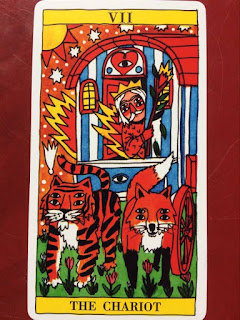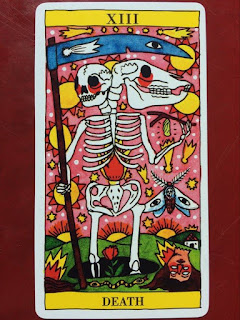Tarot del Fuego - The Chariot - 7
The traditional Hermetic keyword that always sticks out the most for me with the Chariot is "Victory." It shares this keyword with the seventh Sephira of the Kabbalistic Tree of Life, Netzach (it is worth noting, however, that the Major Arcana are the pathways between the Sephiroth, they are not the Sephiroth themselves). Why is the Chariot associated with Victory, though, in the context of Spirit's involvement with Matter? In the Tantric worldview, this principle is called Kalā, "Limited Agency," the power of Limited Action. This kind of seems bad at a glance. Who celebrates having restrictions imposed upon them? Well, if you are Spirit and your objective is to become involved in the sphere of Matter, this stage is a landmark success. This is the first principle where Spirit is able to act from the perspective of a specific entity.
This limited power of action that the Tantrik cosmology describes is the first of a series of 5 kañchukas. Where Principles 1-5 represented the five unbounded divine powers that characterize unconditioned Consciousness-absolute, the 5 kañchukas represent these same powers after the voluntary assumption of limitation. Limitation, here, is simply a particular set of parameters which offer Consciousness a defined space in which to perform the functions of an individual. The word, kañchuka, literally means "sheath" or "armor." These sheaths are conceived of as a series of shells, one within the other, like a set of Russian nesting dolls.
Astrologically, this card represents the constellation of Cancer, the crab, whose natives are notoriously as guarded as the literal crab is by its shell. The Hebrew letter corresponding to the Chariot is Cheth, which represents a field and the fence surrounding it. Paul Foster Case, too, links this correspondence back to the idea of protection and defense, as that is the function of the wall. The cultivated field is the hallmark of civilization and implies domesticity. It is the source of food that people take into and enjoy in their homes as sustenance. These, too, are areas of life governed by the nurturing sign of Cancer, who is ruled by the Moon. In the corresponding section of his Tantra Illuminated, Christopher Wallis contributes another idea that ties into the themes of Cancer that we are presently exploring (by way of the Moon's rulership of Cancer).
It is worth noting here that the TdF Chariot isn't actually a chariot. It's a vardo, a Romani caravan. Epigenetic sequencing from all over Europe and Asia has recently proven that the Romani people (commonly known by the racial epithet "gypsy," which I will not be using going forward) are descended from a group of ethnic Indians called Rajputs (literally "sons of princes"). The Rajputs were genetically similar to Sikhs in present-day India. This group of Rajputs were cut off from the Indian subcontinent by invading Muslims. Apparently defeated in battle and unable to return home, they made their way north. At a certain point, the diaspora forked. One group went west into Mesopotamia, while another group continued to migrate north, making their way throughout the whole of Europe and, eventually, the Americas over the course of approximately 1,000 years. This story of a people separated from their homeland and keeping at least some vestiges of a cultural identity intact over such a great span of distance and time, I think, is a good metaphor for the journey upon which Consciousness is embarking at this level of manifestation.
This limited power of action that the Tantrik cosmology describes is the first of a series of 5 kañchukas. Where Principles 1-5 represented the five unbounded divine powers that characterize unconditioned Consciousness-absolute, the 5 kañchukas represent these same powers after the voluntary assumption of limitation. Limitation, here, is simply a particular set of parameters which offer Consciousness a defined space in which to perform the functions of an individual. The word, kañchuka, literally means "sheath" or "armor." These sheaths are conceived of as a series of shells, one within the other, like a set of Russian nesting dolls.
Astrologically, this card represents the constellation of Cancer, the crab, whose natives are notoriously as guarded as the literal crab is by its shell. The Hebrew letter corresponding to the Chariot is Cheth, which represents a field and the fence surrounding it. Paul Foster Case, too, links this correspondence back to the idea of protection and defense, as that is the function of the wall. The cultivated field is the hallmark of civilization and implies domesticity. It is the source of food that people take into and enjoy in their homes as sustenance. These, too, are areas of life governed by the nurturing sign of Cancer, who is ruled by the Moon. In the corresponding section of his Tantra Illuminated, Christopher Wallis contributes another idea that ties into the themes of Cancer that we are presently exploring (by way of the Moon's rulership of Cancer).
Note that in other contexts kalā also means a sliver of the moon, i.e., the amount that the moon grows in a single day. On the spiritual path, we are waxing from a mere sliver of divine power toward the total fullness of our capacity to express our innate divinity.The TdF Chariot depicts an individual peering out of his vehicle in the way you or I might imagine a newly embodied Consciousness peering out of its shell. It's a pretty cool shell though. It allows us to move, to grasp, to speak, and to do anything else that we might do in the course of traveling through the world. It is drawn by a tiger and a fox, representing passion and intellect respectively. For better or for worse, these will carry us throughout our lives according to our nature.
It is worth noting here that the TdF Chariot isn't actually a chariot. It's a vardo, a Romani caravan. Epigenetic sequencing from all over Europe and Asia has recently proven that the Romani people (commonly known by the racial epithet "gypsy," which I will not be using going forward) are descended from a group of ethnic Indians called Rajputs (literally "sons of princes"). The Rajputs were genetically similar to Sikhs in present-day India. This group of Rajputs were cut off from the Indian subcontinent by invading Muslims. Apparently defeated in battle and unable to return home, they made their way north. At a certain point, the diaspora forked. One group went west into Mesopotamia, while another group continued to migrate north, making their way throughout the whole of Europe and, eventually, the Americas over the course of approximately 1,000 years. This story of a people separated from their homeland and keeping at least some vestiges of a cultural identity intact over such a great span of distance and time, I think, is a good metaphor for the journey upon which Consciousness is embarking at this level of manifestation.



Comments
Post a Comment